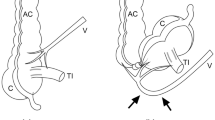Abstract
The purpose of this study is to report the computed tomography (CT) features of cecal volvulus and to determine the accuracy of CT in distinguishing the three pathophysiological types of cecal volvulus. The CT studies of ten patients with surgically confirmed cecal volvulus were reviewed. For each patient, CT findings were looked for and recorded. The precise location of the cecum within the abdomen, the presence of an ileocecal twist, and the clockwise or counterclockwise direction of the whirl sign were specifically analyzed. All these results were confronted to the surgical diagnosis retrospectively correlated with the three types of cecal volvulus. According to our classification based on the analysis of the location of the cecum within the abdomen and the presence or the absence of a whirl sign on CT scans, the cecal volvulus was defined as the axial torsion type in four (40%) patients, loop type in four (40%) patients, and cecal bascule type in two (20%). For each patient, the result was in full accordance with the type of cecal volvulus diagnosed at surgery. CT is not only a valuable diagnostic technique in diagnosing cecal volvulus and its complications, but it is also useful in distinguishing the three pathophysiological types of cecal volvulus.




Similar content being viewed by others
References
Wright TP, Max MH (1988) Cecal volvulus: review of 12 cases. South Med J 81:1233–1235
Madiba TE, Thomson SR (2002) The management of cecal volvulus. Dis Colon Rectum 45:264–267
Perrer RS, Kunberger LE (1998) Cecal volvulus. Am J Roentgenol 171:860
Moore CJ, Corl FM, Fishman EK (2001) CT of cecal volvulus: unraveling the image. Am J Roentgenol 177:95–98
Berger JA, van Leersum M, Plaisier PW (2005) Cecal volvulus: case report and overview of the literature. Eur J Radiol Extra 55:101–103
Frank AJ, Goffner LB, Fruauff AA, Losada RA (1993) Cecal volvulus: the CT whirl sign. Abdom Imaging 18:288–289
Montes H, Wolf J (1999) Cecal volvulus in pregnancy. Am J Gastroenterol 94:2554–2556
Torreggiani WC, Brenner C, Micallef M (2001) Case report: cecal volvulus in association with a mesenteric dermoid. Clin Radiol 56:430–432
Rabin MS, Richter IA (1978) Cecal bascule: a potential clinical and radiological pitfall. Case reports. S Afr Med J 54:242–244
Bharti K (2003) The whirl sign. Radiology 226:69–70
Shaff MI, Himmerlfarb E, Sacks GA, Burks DD, Kulkami LD (1985) The whirl sign: a CT finding in volvulus of the large bowel. J Comput Assist Tomogr 9:410
Author information
Authors and Affiliations
Corresponding author
Rights and permissions
About this article
Cite this article
Delabrousse, E., Sarliève, P., Sailley, N. et al. Cecal volvulus: CT findings and correlation with pathophysiology. Emerg Radiol 14, 411–415 (2007). https://doi.org/10.1007/s10140-007-0647-4
Received:
Accepted:
Published:
Issue Date:
DOI: https://doi.org/10.1007/s10140-007-0647-4




